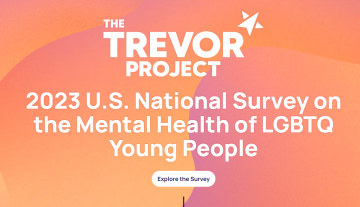
This year, more than 30 bills are making their way through the New Hampshire Legislature that target LGBTQ+ youth and families.
These proposed laws not only discriminate against LGBTQ+ Granite Staters, but also pose a threat to their overall health and well-being. Nearly 1 in 3 LGBTQ young people said their mental health was poor most of the time or always due to anti-LGBTQ policies and legislation.
There's a lot of misinformation over these bills and the facts need to be separated from the myths.
Sports Participation
MYTH:
Trans student-athletes have an unfair physical advantage over other student-athletes.
FACT:
Trans student-athletes vary in athletic ability just like all student-athletes. Natural variations in physical characteristics are part of sports, especially at younger ages when youths’ bodies are undergoing tremendous change at varying speeds. Like all youth, trans youth are short and tall, strong and not, fast and slow.1
MYTH:
Trans student-athletes should be on separate sports teams from other student-athletes.
FACT:
Trans student-athletes belong on the same teams as other student-athletes. In fact, tens of thousands of transgender and non-binary students nationwide have been playing sports for years without any unfair advantages or problems.2
Sports and athletics are an important part of childhood, offering opportunities to build a sense of belonging and learn important life skills like teamwork, leadership, confidence, and self-discipline. The overwhelming majority of transgender youth, like most kids, don’t play at elite levels; they just want to participate with their peers.
MYTH:
Major sports organizations do not support trans girls’ participation in girls’ sports.
FACT:
The NH Interscholastic Athletic Association has allowed trans athletes to participate since 2015 before the NCAA. 10 National sports organizations like the NCAA allow some transgender student-athletes to participate on teams that align with their gender identity. They don’t have sports-wide bans, but rather specific policies that vary by sport.3 Sports governing bodies are best equipped to make their own policies and do not need interference from politicians.
MYTH:
Trans girls will take spots on the team from other girls.
FACT:
Like all student-athletes, trans student-athletes have varying interest in playing sports, degrees of seriousness and committment to sports, and degrees of physical ability and attributes that may or may not lend themselves to success in the sport of their choice.1
MYTH:
Sports bans are harmless to trans people.
FACT:
Excluding trans student-athletes from playing sports is harmful and has negative consequences to their well-being. Alternatively, when trans youth have access to gender-affirming spaces and activities, they have better mental health, educational, and social outcomes. A 2023 national survey conducted by the Trevor Project found that roughly half of transgender and nonbinary young people found their school to be gender-affirming, and those who did reported lower rates of attempting suicide.4
Censorship in Schools
MYTH:
Teachers are hiding information about students from their parents.
FACT:
Parents and teachers should be partners, not pitted against each other. Sometimes, a student may feel more comfortable coming out as gay or trans to friends or a trusted adult at school before they're ready to tell their parents. Teachers can listen to students without inserting themselves in a family dynamic.
MYTH:
Forced outing protects parental rights.
FACT:
Forced outing endangers LGBTQ+ youth. Many parents may hope their children will come to them first with questions about gender and sexuality. But not every child has that option. Trans people are more likely to be abused by their immediate family based on their gender identity, and high risks of abuse and family rejection mean trans youth are overrepresented in foster care homes, juvenile detention centers, and homeless shelters. These high rates of familial rejection and abuse dramatically increase the risks of suicidality, substance abuse, and depression.5
MYTH:
There's no harm for students resulting from forced outings.
FACT:
Not all youth are safe at home. In a survey conducted by the Trevor Project, fewer than 40% of LGBTQ+ young people found their home to be LGBTQ-affirming.4
School may be one of the few places where some youth feel safe and supported. Roughly half of transgender and nonbinary young people found their school to be gender-affirming, and those who did reported lower rates of attempting suicide. 4 Many schools across the country recognize that a supportive learning environment requires treating trans students with dignity and respect, including calling them by the name and pronouns they want to use. 5
A study conducted by UConn’s Sexuality, Health, and Intersectional Experiences (SHINE) Lab found that youth who were outed to their parents were more likely to experience elevated depressive symptoms and lower LGBTQ family support compared to those who were not. Parents who affirmed and supported their child’s identity could potentially mitigate depressive symptoms from the stress of being outed.6
Disrimination in Public Spaces
MYTH:
Transgender people will violate modesty norms in restrooms and locker rooms.
FACT:
Transgender people value privacy like everyone else—maybe even more so. They have every reason to avoid drawing attention to their differences, because they are disproportionately victims of violence and harassment.7
In a 2023 survey by the Trevor Project, a majority of LGBTQ+ young people reported being verbally harassed at school because people thought they were LGBTQ+. 4 Transgender students, like all students, just want to use the restroom in privacy.
MYTH:
Allowing transgender women in women’s facilities poses a safety risk.
FACT:
Transgender people aren’t inherently dangerous. Over 18 states have nondiscrimination laws protecting transgender people’s access to facilities, including bathrooms, consistent with the gender they live every day. None of those jurisdictions have seen a rise in sexual violence or other public safety issues due to nondiscrimination laws. Assaulting another person in a restroom or changing room remains against the law in every single state.8
Health Care
MYTH:
Gender affirming care is unsafe.
FACT:
Gender-affirming care is medically necessary, age-appropriate, and often life-saving for transgender people. It is supported by major medical authorities like the American Academy of Pediatrics and the American Medical Association.
Puberty-blocking medications and hormone therapy for trans youth and adults have been prescribed and studied by experts for over 40 years. Young people seeking gender-affirming medical care first receive significant counseling and a psychological assessment.
Like all medical interventions, surgical care is highly individual, and only undertaken after significant consultations with experts.9
MYTH:
Laws that ban gender affirming care are protecting kids.
FACT:
When legislation attempts to regulate who can access gender-affirming care, it inserts politics into private and personal conversations between parents and their children, and patients and their doctors. These laws are not about safety — as the safety, efficacy, and life-saving nature of gender-affirming care for transgender and non-binary youth and adults is clear. Instead, they are attempting to enshrine discrimination into law.
Rather than protecting kids, these laws are preventing parents and young people from making informed medical decisions, and doctors and health care providers from providing best-practice care to their patients.9
MYTH:
Doctors regularly perform gender-affirming surgery on young children.
FACT:
Any surgical care for youth under 18 is rare and individualized. When it does happen, it’s typically chest, not genital, surgery and is in older teenagers. If surgery is deemed medically necessary, it does not happen right away. Young people must have gender dysphoria for at least six months before receiving a diagnosis, and the process of getting any type of gender affirming care takes time.
MYTH:
Transgender people who receive gender affirming care as youth regret it as adults.
FACT:
Previous studies have found that de-transitioning is quite rare —with some studies finding levels of de-transition and regret as low as 1% or 2%. Transgender youth who meet the criteria for gender dysphoria and who undergo social or medical transition are actually the least likely to de-transition — and the vast majority of transgender youth remain consistent and persistent in their gender identity over time.
Further, evidence-based standards of care exist to ensure that no one, regardless of their age, undergoes any permanent, irreversible changes without informed consent and careful consultation with medical and mental health care providers.9
MYTH:
All trans people want a complete transition.
FACT:
For some trans people, hormones and surgery are a vital part of affirming their gender and feeling comfortable in their bodies, but not for all. Some will have one without the other, while others will forgo medical treatments altogether.
MYTH:
Being transgender is a mental illness.
FACT:
There is nothing inherent to being trans that makes a person more likely to experience poor mental health. Rather, as one of the most socially and medically marginalized groups in society, poor mental health is a common and unsurprising outcome.
References:
- Get the facts about transgender & non-binary athletes. Human Rights Campaign. (n.d.). https://www.hrc.org/resources/get-the-facts-about-transgender-non-binary-athletes
-
Myths and Facts: Battling disinformation about transgender rights. (n.d.). Human Rights Campaign. Retrieved March 14, 2024, from https://www.hrc.org/resources/myths-and-facts-battling-disinformation-about-transgender-rights
- Transgender Student-Athlete Participation Policy. (2023, April 17). NCAA.org. Retrieved March 14, 2024, from https://www.ncaa.org/sports/2022/1/27/transgender-participation-policy.aspx
- The Trevor Project. (2023). 2023 U.S. National Survey on the Mental Health of LGBTQ Young People. Retrieved March 14, 2024, from https://www.thetrevorproject.org/survey-2023/assets/static/05_TREVOR05_2023survey.pdf
-
Seldin, H. (2023, January 26). Trans students should be treated with dignity, not outed by their schools | ACLU. American Civil Liberties Union. https://www.aclu.org/news/lgbtq-rights/trans-students-should-be-treated-with-dignity-not-outed-by-their-schools
- Faipler, D. (2024, February 28). Stress of being outed to parents and caregivers: What are the mental health consequences? UConn Today. https://today.uconn.edu/2024/02/stress-of-being-outed-to-parents-and-caregivers-what-are-the-mental-health-consequences/
-
Georgia Unites Against Discrimination. (2018, December 18). Mythbuster - Georgia unites against discrimination. https://georgiaequality.org/georgiaunites/mythbuster/
-
ABC News. (2016, April 22). Sexual assault and domestic violence organizations debunk “Bathroom Predator myth.” ABC News. https://abcnews.go.com/US/sexual-assault-domestic-violence-organizations-debunk-bathroom-predator/story?id=38604019
- Get the Facts on Gender-Affirming Care (2023, July, 25). Human Rights Campaign. Retrieved March 14, 2024, from https://www.hrc.org/resources/get-the-facts-on-gender-affirming-care
-
NHIAA. (n.d.). NHIAA Handbook (By-Law Article II Eligibility). https://www.nhiaa.org/ckfinder/userfiles/files/4HB%2021-22%20%20II%20Eligibility.pdf





